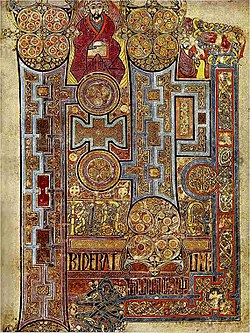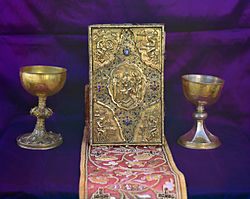Gospel Book

AGospel Book,Evangelion,orBook of the Gospels(Greek:Εὐαγγέλιον,Evangélion), is acodexor bound volume containing one or more of the fourGospelsof theChristianNew Testament– normally all four – centering on the life ofJesus of Nazarethand the roots of the Christian faith. The term is also used for aliturgical book,also called theEvangeliary,from which are read the portions of the Gospels used in the Mass and other services, arranged according to the order of theliturgical calendar.[1]
Liturgical use in churches of a distinct Gospel book remains normal, often compulsory, inEastern Christianity,and very common inRoman Catholicismand some parts ofAnglicanismandLutheranism.
History
[edit]
In theMiddle Ages,the production of copies of theBiblein its entirety was rare because of the huge expense of theparchmentrequired. Individual books or collections of books were produced for specific purposes. From the 4th century Gospel Books were produced for liturgical use, as well as private study and as "display books" for ceremonial and ornamental purposes.[2]TheCodex Washingtonianus(Freer gospels) is an early example of a book containing only the four gospels, in Greek, written in the 4th or 5th century. By the 7th century particular gospel texts were allocated to days in theliturgical calendar;previously gospel readings had often worked through the books in sequence.[3]Many of these volumes were elaborate; the Gospel Book was the most common form of heavilyilluminated manuscriptuntil about the 11th century, when the Romanesque Bible andPsalterlargely superseded it in the West. In the East they remained a significant subject for illumination until the arrival of printing. TheEvangelist portraitwas a particular feature of their decoration.[4]Most of the masterpieces of bothInsularandOttonianillumination are Gospel Books.[5]
But most Gospel Books were never illuminated at all, or only with decoratedinitialsand other touches. They often contained, in addition to the text of the Gospels themselves, supporting texts includingCanon Tables,summaries, glossaries, and other explanatory material. Latin books often include theLetter of Jerome to Pope DamasuswhereJeromeset out to the Pope the reasoning behind his newVulgatetranslation and arrangement of the texts, and many Greek ones theEpistula ad Carpianum(Letter to Carpian) ofEusebius of Caesareaexplaining theEusebian Canonshe had devised.[6]
Luxuriously illuminated gospel books were mainly a feature of theEarly Middle Ages,as the evangeliary or a generallectionarygradually became more common for liturgical use, and other texts became most favoured for elaborate decoration.[7]
Western use
[edit]Roman Catholicism
[edit]
In currentRoman Catholicusage, the Book of the Gospels orEvangeliary[1]contains the full text of the passages from all fourgospelsthat thedeaconorpriestis to read or chant atMassin the course of theliturgical year.However, use of the Book of the Gospels is not mandatory, and the gospel readings are also included in the standardLectionary.[8][9]
The Book of the Gospels, if used, is brought to the altar in the entrance procession, while the Lectionary may not.[10]When carried in procession, the Book of the Gospels is held slightly elevated, though not over the head. It is particularly proper for the deacon to carry the Book of the Gospels in procession, as the reading of the gospel is his particular province. When there is no deacon, the Book may be carried by alector.[11]Upon reaching thealtar,the deacon or lector bows in veneration of the altar, then places the Book upon the altar, where it remains until theAlleluia.[12]
During the singing of the Alleluia, the deacon (who before proclaiming the gospel receives the presiding priest's blessing), or in his absence, a priest, removes the Book from the altar and processes with it to theambo.Ifincenseis used, the Book of the Gospels iscensedby the deacon before the reading or chanting. Analtar serveroracolytewill swing the censer slowly during the reading or chanting.[13]The Book of the Gospels remains on the ambo until the Mass concludes, unless it is taken to a bishop to be kissed, after which it may be placed on the credence table or another appropriate and dignified place.[14]
Lutheranism
[edit]In theLutheran Churches,the Book of the Gospels is "carried in procession".[15][16]
Anglicanism
[edit]
In theEpiscopal Church in the United States of Americathe practice of using a Gospel Book was recovered with the1979Book of Common Prayer,which suggests that the lessons and gospel "be read from a book or books of appropriate size and dignity".[17]
Eastern use
[edit]
This section is empty.You can help byadding to it.(February 2023) |

Significant gospel books
[edit]
See also the categories at bottom.
- Rossano Gospels
- Rabula Gospels
- Mulling Gospels
- Book of Durrow
- Domnach Airgid
- Echternach Gospels
- St. Augustine Gospels
- Stonyhurst orSt Cuthbert Gospel(St John only)
- Durham Gospels
- Lindisfarne Gospels
- Lichfield Gospels(also known as the St. Chad Gospels)
- Leningrad Gospels
- Book of Kells
- Barberini Gospels
- Vienna Coronation Gospels
- Aachen Coronation Gospels
- Ada Gospels
- Ebbo Gospels
- Codex Aureus of St. Emmeram
- Lorsch Gospels
- Codex Aureus of Echternach
- Emperor's Bible
- Gospels of Henry the Lion
- Miroslav Gospels
- Gospels of Tsar Ivan Alexander
- Peresopnytsia Gospels
Notes
[edit]- ^ab"General Instruction of the Roman Missal, 44"(PDF).Catholic Bishops' Conference of England & Wales.Catholic Truth Society.Retrieved2 February2015.
Among gestures included are also actions and processions: of the priest going with the deacon and ministers to the altar; of the deacon carrying theEvangeliaryorBook of the Gospelsto the ambo before the proclamation of the Gospel...
- ^Calkins, 31
- ^Calkins, 18-19
- ^Calkins, 23-29, and chapters 1 and 3
- ^Calkins, chapters 1 and 3 deals with these in turn
- ^Calkins, 25
- ^Calkins, 148-150
- ^Deiss, 36-37
- ^""The Proclamation of the Gospel at Mass" (The Catholic Liturgical Library) ".Archived fromthe originalon 2018-04-18.Retrieved2015-02-02.
- ^General Instruction of the Roman Missal, 120
- ^Deiss, 38-39
- ^Commentary, 128
- ^Paul Turner, "The Book of the Gospels"
- ^Edward McNamara, "A Place for the Book of the Gospels"
- ^Eckardt, Burnell; Frahm, John A. (6 July 2017)."Give Attention to the Public Reading of Scripture: I Timothy 4:13: Lectors, Pastoral Stewardship, and Gender Considerations".Gottesdienst: The Journal of Lutheran Liturgy.Retrieved8 October2023.
- ^Boxall, Ian; Gregory, Bradley C. (22 December 2022).The New Cambridge Companion to Biblical Interpretation.Cambridge University Press. p. 358.ISBN978-1-108-49092-4.
- ^1979 USBook of Common Prayer,p. 406
References
[edit]- Calkins, Robert G.Illuminated Books of the Middle Ages.1983, Cornell University Press,ISBN0500233756
- "Commentary", Edward Foley, John Francis Baldovin, Mary Collins, Joanne M. Pierce, eds.,A Commentary on the Order of Mass of the Roman Missal,2011, Liturgical Press, 2011,ISBN0814662471,9780814662472
- Deiss, Lucien,The Mass,1992, Liturgical Press,ISBN0814620582,9780814620588
- Otto Pächt,Book Illumination in the Middle Ages(trans fr German), 1986, Harvey Miller Publishers, London,ISBN0199210608
- Palazzo,Eric,A History of Liturgical Books from the Beginning to the Thirteenth Century,1998, Liturgical Press,ISBN081466167X,9780814661673,google books
External links
[edit]- Getty Museum feature on gospel books,andanother
- Photo of Orthodox deacon holding Gospel Book
- Photo of Paschal Liturgy(the Gospel Book can be seen lying on theEpitaphios)
- Reading the GospelatAll-Night Vigil
- Photo of Confession
- Photo of Gospel Book enthroned at council
- Photo of deacon reading the Gospel
- Funeral of an Orthodox Bishop(St. John Maximovitch) showing Gospel Book in coffin
- Jewelled Gospel book-Romanov collectionat theAlexander Palace
